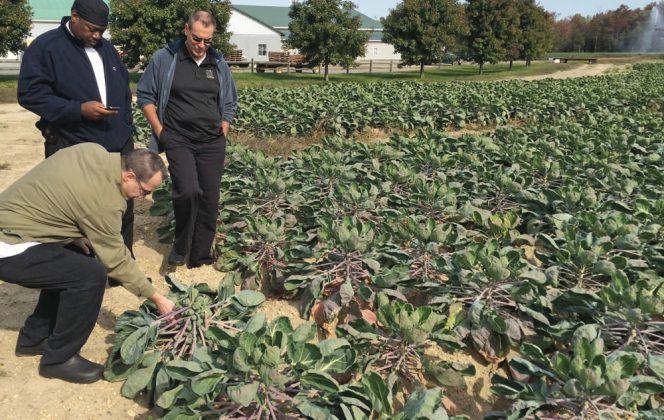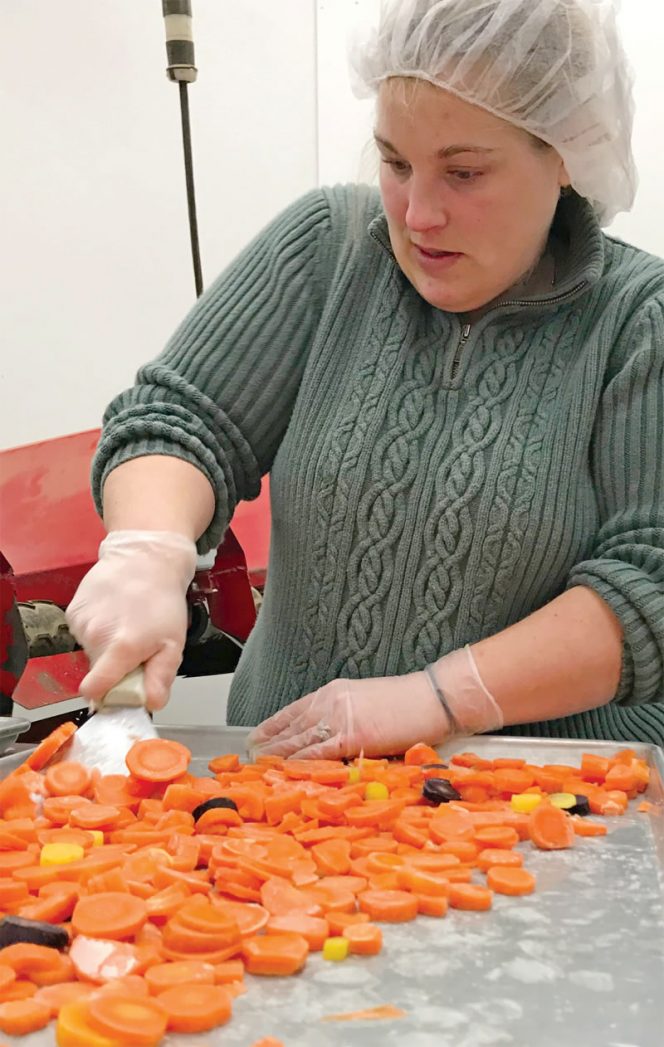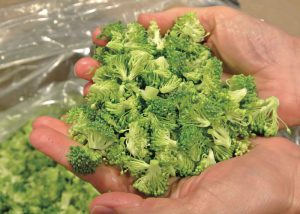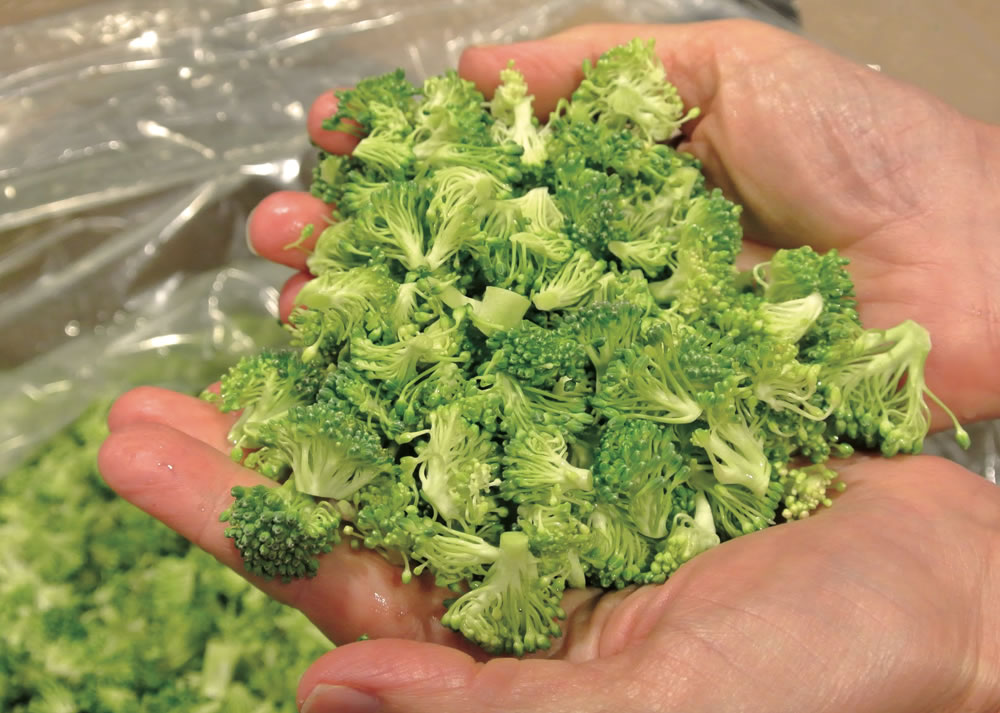Gleaning and minimal processing have facilitated enterprise development and markets for edible produce that is unharvested or cosmetically imperfect. Part I
Marsha W. Johnston
BioCycle February 2018

Bon Appétit brings its chefs to the farm fields to see if there are products they can use, such as Brussels sprout leaves. Photo courtesy of Bon Appétit Management Company
The 2016 ReFED (Rethink Food Waste through Economics and Data) Roadmap (ReFED.com) report released in Spring 2016 calculated that 10 million tons of cosmetically imperfect or unharvested food are lost each year on farms. The exact quantity remains uncertain, in part because growers are not required to report their losses, categorized in the agricultural sector as “postharvest loss,” “oversupply”, “culls” or “seconds.”
In his book Waste: Uncovering the Global Food Scandal, Tristam Stuart declared that “the exact quantity of waste from farms is the biggest unknown of all waste statistics.” As the Fink Family Foundation noted upon releasing the ReFED Roadmap, whatever the quantity of on-farm wasted food, eliminating it will require America to, among other things, “unleash its spirit of innovation to develop new technology and business-model innovations.”
Such innovation is clearly underway. A late November webinar organized by Salvation Farms in Morristown, Vermont and hosted by the Harvard University Food Law and Policy Clinic as part of its Food Recovery Entrepreneur Workshop Steering Committee’s work, detailed recent successes and challenges among some of the sector’s pioneers. Part I of this article discusses Salvation Farms and its commodity project, and an initiative by Bon Appétit Management Co. Part II reports on Boston Area Gleaners, Commonwealth Kitchen and Hungry Harvest.
Salvation Farms And Vermont Commodity
Theresa Snow, Salvation Farms’ founder and director, began the webinar by reporting that, in 2016, her organization made the first statewide attempt to quantify the food left on farms in Vermont. Based on farmer estimates, it was calculated to be approximately 14 million pounds of edible vegetables and berries.
Salvation Farms began as a gleaning program in 2005 in Lamoille County to build more resilience into Vermont’s food system. Organizing volunteers and farmers, many of whom Snow had worked for as an employee, Salvation Farms harvested and distributed the produce primarily to charitable food sites to avoid competing with any of the farmers’ markets. The gleaning operation grew into the Vermont Gleaning Collective, a statewide collective of autonomous gleaning organizations. “We wanted to bring diverse, regionally based gleaning organizations from around the state together for network building, to think about best practices and how we track it in the same way, how we serve farms professionally, how we handle food safely, and how we educate and engage our community,” Snow explains.

Trainees at the Vermont Commodity Program work 5 days a week for 16 weeks packing and minimally processing whole produce that has been gleaned, culled or donated. Photo courtesy of Salvation Farms
With the collective established, Salvation Farms launched a new social venture called the Vermont Commodity Program (VCP) last September, which Snow describes as the group’s “effort at having a surplus crop food hub.” It is also a workforce development program, says Diane Abruzzini, a sustainable entrepreneurship advisor to Salvation Farms and VCP. A social venture is an emerging new business model that applies commercial strategies — a revenue-generating business — to maximize the benefit to social, environmental and economic well being — a nonprofit mission — for the organization and its stakeholders. A successful social venture can accomplish the public benefit of a nonprofit while remaining more financially independent and thus sustainable, regardless of external economic and political factors. “This is a social venture because the act of taking in, packing and sending out product is both revenue building and a benefit to trainees, farmers and the Vermont food system,” adds Abruzzini.
The VCP is located at a 5,000-square-foot facility in Morristown that includes a commercial kitchen. Trainees work 5 days a week for 16 weeks packing and minimally processing (chopping, freezing) whole produce that has been gleaned, culled or donated from Vermont farmers’ wash/pack/storage houses. In addition to certification training for positions in food manufacturing, VCP trainees receive soft skills development and career coaching, preparing them to search and apply for jobs. “But operationally they help us handle tons of high quality surplus that we can move into outlets that serve more people in Vermont,” notes Snow. From September 2016 through May 2017, VCP operated two training cycles and handled approximately 170,000 pounds of mainly storage crops. “That was primarily the off-season,” she adds. “The challenge will be the peak season, with more highly perishable crops.”
Part of the space is sublet to another catering company because VCP uses the kitchen less than one day a week, as the trainees work every day in a separate packing room that stores most of its necessary equipment. Such partnerships are “hugely beneficial” for underutilized assets like a commercial kitchen that are expensive to maintain, says Abruzzini.
Adding Institutional Buyers
Currently, all of VCP’s products — whole raw or minimally processed produce — enter the region’s charitable food system. However, one of the program’s goals is to purchase surplus or seconds directly from farmers and begin selling whole and minimally processed produce to institutional buyers.
VCP’s first institutional target is the Vermont Department of Corrections (VDOC). “Because we’re using second quality or gleaned, we’re paying below market rate, which allows us entry into markets that haven’t been able to purchase locally, the first one being the prison system,” explains Abruzzini.
Distributing farmers’ underutilized on-farm surplus produce to prisons that spend over $3 million/year on food seems like a logical fit, she adds. However, VCP still has to make a clear case for meeting the VDOCs’ precise needs. The Department’s primary concern is adhering to a strict food budget and using 100 percent of what it buys. VCP’s data on its efficiency rates for processing second quality produce can be used as a selling point, particularly if it is better than in-house prep. “Prisons know they have a certain number of cents per vegetable per portion per meal and if they are losing 10 to 20 percent of the volume of their purchases due to peeling, coring, etc., they are losing value,” Abruzzini says. VCP is working with the VDOC’s central office on a more centralized buying pattern, and already has one prison buyer who is interested in taking product on a trial basis.
At the same time, VCP sells farms on its ability to provide labor with food handling, packing and harvesting skills that can give much needed mid-season help and offset the farm selling produce slightly below market value for a given product destined for the prison market. “The Vermont Commodity Program has been an incredible experience to forge into new territory, a program that really has not been done anywhere,” Abruzzini adds.
Bon Appétit Management Co.
Stopping edible food from being wasted on farms in the first place was the inspiration for Bon Appétit Management Co.’s Imperfectly Delicious Produce program, explains Maggie Kraft, Bon Appétit’s waste specialist. The food service company, which Kraft says is “committed to cooking from scratch and providing restaurant quality food in places where that hasn’t been the norm,” prepares, manages and serves food at 600 cafes in 33 states, primarily colleges, universities, museums and businesses.

Broccoli “fines”were a hit with Bon Appétit chefs, but the farmer recognized the volume of waste and changed processing equipment. Photo courtesy of Bon Appétit Management Company
At the same time, Bon Appétit is committed to sustainability related to food sourcing, ranging from farm worker protections, to animal welfare and waste. “Overall, our approach is to stop waste from happening, up the supply chain, on farms, in kitchens and in our cafes,” says Kraft.
As part of its commitment to sustainable sourcing, the company’s chefs, managers and corporate officers spend a lot of time on farms where they were seeing a lot of waste. In one instance, Maisie Gansler, Bon Appétit’s chief brand and strategy officer, visited a strawberry farm in California where she saw hundreds of pounds of white-shouldered strawberries getting tossed into a composting pile or left unharvested. Gansler realized these were perfectly good strawberries; Bon Appétit chefs would just cut off the white tops and use them.
In part from that visit, Imperfectly Delicious Produce (IDP) was created in 2014. It aims to identify and rescue produce on farms due to cosmetic imperfections or, in an innovative twist, parts of the plant that are typically not used. Examples of the latter, Kraft notes, are broccoli stalks and kale leaves that the farmer doesn’t harvest because they are “too curly” for the cosmetic demands of produce buyers. “Our goal is truly to rescue produce that is going to end up in compost or the landfill,” she says. “We don’t want to be taking seconds produce that is already bound for other markets, so not apples that could be juiced, but apples that really truly go to composting. That’s something that’s challenging for people to understand.
“Most farmers, when they look at a field of broccoli stalks, they don’t see a field of broccoli stalk coleslaw, but that’s what we see. So we’re really looking for those products that are not getting used. Cooking from scratch, our chefs can turn this into something delicious.”
IDP’s top three challenges, notes Kraft are: rescuing produce from waste streams; connecting chefs to produce; and ensuring a consistent product. In terms of connecting chefs with produce, IDP has to ensure it is from safe and reliable sources and easy to procure. “A lot of our chefs have partnerships with local farmers, and many times the farmer will text them and say, ‘Hey I have some carrots, can you get them?’,” she explains. “But that’s not the primary way for our chefs to get their produce.”
Instead, IDP wants to make sure Bon Appétit chefs have IDP’s products they use every week available in the ordering systems. When Bon Appétit sets up in a new region, IDP meets with the distributor, goes onto the farms where the distributor has partnerships to talk to the farmers, and brings its chefs into the fields to see if there’s product that they can use. “It’s a little bit tedious to make those connections, but it is always very fruitful and worthwhile,” Kraft says. Once a product has been established, chefs expect a certain amount of consistency every time they order, “which can be challenging to do in a market where you are sourcing imperfect produce,” she adds.
An example of a recent such challenge, was a “really awesome product called broccoli `fines’.” “They were these itty-bitty florets that were left over from processing traditional broccoli florets, the larger ones,” Kraft says. “And our chefs loved them. They were bagged up and would be thrown in soups or stews. But the farm saw all of these hundreds of pounds of broccoli fines going into the IDP program and looked at their processing machine and said, `Maybe we need a new machine that’s not so wasteful’, which is awesome. We want there to be less waste and kind of want those broccoli fines to disappear. But we also lost this major, best-selling product of ours, and we have to find something to replace it.”
Looking forward, Bon Appétit wants to keep growing IDP, educating customers and partners. “We want to make it the norm for farmers to look at a field of broccoli stalks and think of IDP products, and empower them to make those decisions,” she adds.
Marsha W. Johnston, an editor with Earth Steward Associates, is a Contributing Editor to BioCycle. Part II of this article reports on Boston Area Gleaners, Commonwealth Kitchen and Hungry Harvest.










